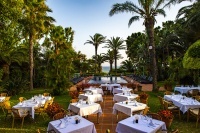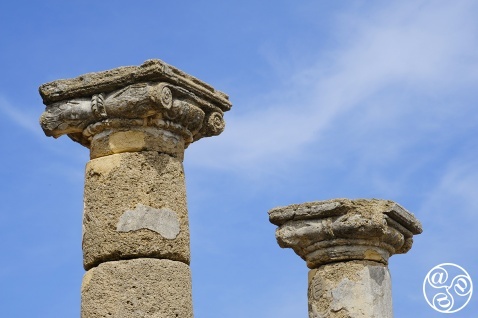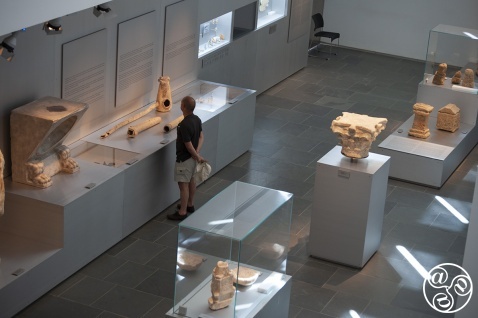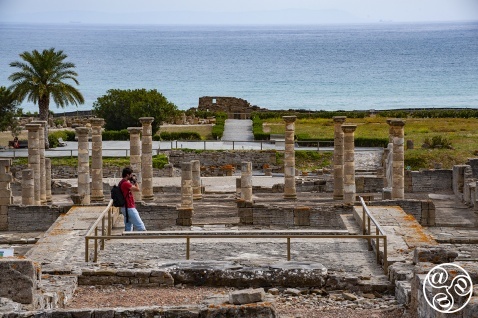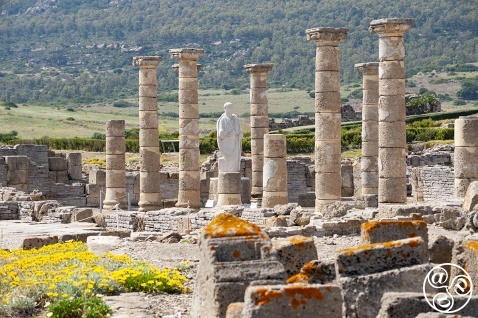
Baelo Claudia, near Tarifa, is one of Andalucia´s most significant and well-preserved Roman archeological sites |
|
BAELO CLAUDIA
Baelo Claudia is one of Andalucia´s most significant and well-preserved Roman archeological sites. The extensive ruins are situated on the Costa de la Luz, some 15km north of Tarifa, by the small town of Bolonia and its beautiful beach. The site´s important history rests on the former city having been a strategic point for trade routes between Europe and North Africa; the Straits of Gibraltar are just 14km wide at their narrowest point, and Baelo Claudia profited from this proximity. The remains of the impressive temple, Forum, basilica, baths, aqueduct, and large fish-salting factory in particular, can all be seen today, giving an insight into the former glory of the city.
Tarifa - built in the Moorish style, set in subtropical gardens leading down to the unspoilt beach.
HISTORY
Baelo Claudia dates back to the Republican period of the 2nd century BC. The city´s central Forum was constructed under Augustus, but it wasn´t until the rule of Claudius (the city´s namesake, 41 – 54 AD) that the monumental complex of the city was established. It was during this time that the site acquired the status of a municipium, attaining its greatest urban and economic splendour.
Several of the city´s buildings underwent demolition or changes in function during the 2nd century AD, but it wasn´t until the 3rd century AD that Baelo Claudia´s decline was really set in motion. Enduring multiple urban redevelopments and earthquakes, the city survived until the 7th century AD.
GEOGRAPHY
The landscape that once afforded Baelo Claudia its strategic maritime position now serves as a beautiful backdrop to the site; set on a gentle incline, visitors get an impressive vista of the white sands of Bolonia beach running from Punta Camarinal to Punta Paloma. The San Bartoleme hills to the East, and the Higuera and Plata mountains to the West, create a sheltered cove that was once beneficial to mooring vessels. Like many Roman cities, the streets of Baelo Claudia were constructed methodically from East to West, and North to South; the space was designed to nestle neatly into the striking coastline.
THE SITE TODAY
The site´s visitor centre acts as the portal into the city. The huge concrete block which houses the centre was objected to by locals when constructed, but actually blends quite well with the dunes. Visitors step into a central atrium, painted white and with a glass balcony framing the coastal view. The centre is a good preface to the ruins, with a scale model of the city in its heyday, and accompanying audio guide. Information boards are paired with artifacts, or reconstructions of lost artifacts, found on the site during its excavation. Examples include a marble statue, presumably of a goddess, found at the Gare of Carteia (one of the principal entry points to the town), and plumb lead piping from the 1st century AD. There is also a restored column from the Basilica, and the ´crown jewel´ of the collection, the Doryphorus of Baelo Claudia, the remains of a marble statue found in the maritime baths depicting a nude male athlete, which indicates the former wealth of the city.
The visitor centre opens up onto the site; you can follow a suggested route, but signage is subtle and visitors can peruse as they please. Beside the remains of the Eastern entry gate is a small stretch of aqueduct that would once have been 5.2km long, bringing the city the water so essential to its baths – the water supply was such a priority that the streets were waterproofed with a lining of opus signinum. The remains of the baths themselves are to the West of the central Forum. They would once have consisted of both sport and leisure spaces, with large and luxurious thermae and smaller, private balneae, and the water supplied by the aqueduct was heated by external furnaces.
More social spaces in the site include the Forum South Square, with 12 remaining columns of varying quality standing around it. The basilica of the 1st century AD would once have stood around this space, providing a centre of justice and the town´s principal civic site. The amphitheatre to the North of the site is one of the most effectively reconstructed spaces. Its seating occupies a natural slope, and the caveae (vaulted entrances to the seating area) have been fully restored. This space is still used today, with a modern stage and seating serving audiences during summer productions of classical Spanish theatre. A kind of ´highstreet´ runs nearer the sea, with the foundations of kiosk-like shops, and original steps which visitors can tread. These spaces provide an indication of the systems of town planning employed by the Romans.
The maritime centre on the southernmost edge of the site is the most crucial insight into the city´s former industry. The many restored curved dips of the salt baths, into which tuna would be layered with salt for preservation, reflect Baelo Claudia´s strategic role as the main port connecting with Tingis (Tangiers). This was the industry that funded the city´s urban growth, and the fixed net fishing method used by the Romans is echoed in the almadraba nets of today.
It is difficult to imagine the vastness of Baelo Claudia in its day, but the site is still one of the best-preserved in Andalucia. The beautiful setting alone justifies a visit, but the scale of the remains, and the many unobtrusive information boards around the site, make it a crucial destination for those interested in classical antiquity.
Cinema
In October 2021 Baelo Claudia was used as the set for the Netflix series 'The Crown'. It was filmed as Princess Diana's visit to Egypt in 1992. News
Buy tickets for excursions to Baelo Claudia
OPENING HOURS
1 Jan to 31 Mar and 16 Sep to 31 Dec: Tue to Sat 9:00 - 18.00 hrs, Sun and Hols 9:00 - 15:00.
1 Apr to 30 Jun: Tue to Sat 9:00 - 21.00, Sun and Hols 9:00 - 15:00.
1 July to 15 Sep: Tue to Sat 9:00 - 15:00 and 18.00 - 21.00, Sun and Hols 9:00 - 15:00.
Monday Closed
Local Holidays (Tarifa) 16 Jul & 8 Sep: 9:00 to 15:00
Holidays Closed: 1 Jan, 6 Jan, 1 May, 24 Dec, 25 Dec, 31 Dec.
In the summer theatrical evenings are arranged in the amphitheatre. Tickets available.
Guided tours
Guided tours available by prior appointment.
Contact
Tel: 956 10 67 97
[email protected]
FEE
Entry is free to EU citizens on production of an ID card or passport. Otherwise the entrance fee is 1.50 euro.
Leaflet
Download information leaflet in PDF (400kB)
LOCATION
Address: Ensenada de Bolonia s/n, Tarifa, 11380 (Cadiz).
Directions: Take the N-340 main road and at km 70.2 turn off onto the CA-8202 Local road and continue until you reach the village of Ensenada Bolonia. Continue straight on rather than turning left to the beach and in 500m you will see the visitor centre and its free Car Park on the left hand side.
